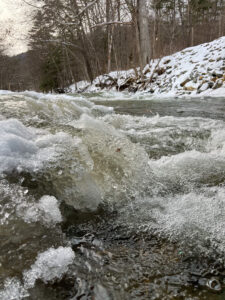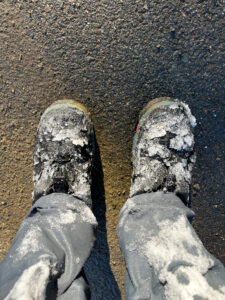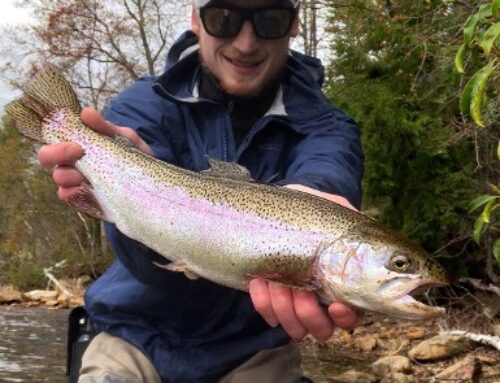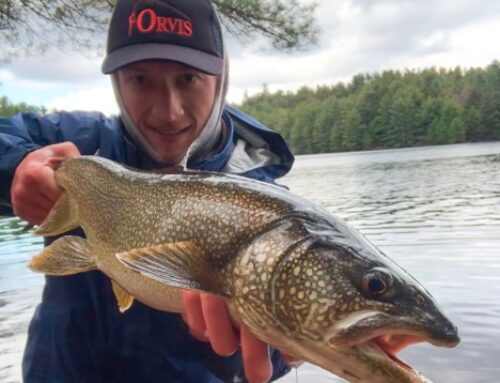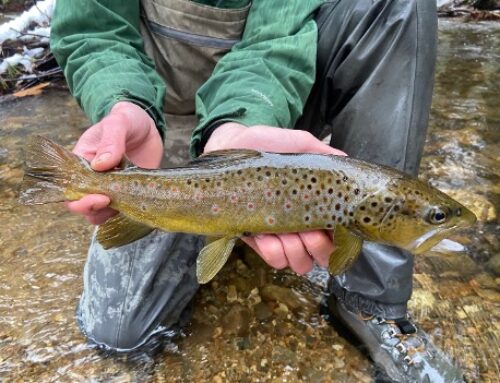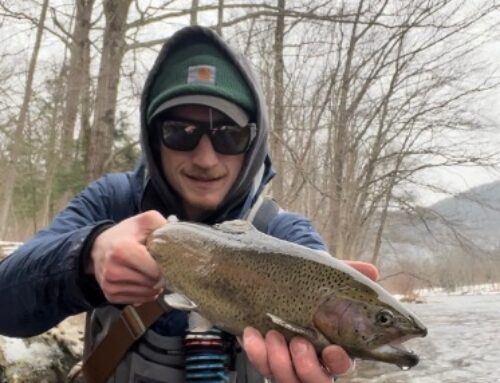Welcome to the 2024 season! We hope everyone enjoyed a nice holiday and is looking forward to another awesome year of angling here in beautiful western Massachusetts.
Our first significant cold spell arrived last week and now we are in full winter mode. Make sure to take necessary safety precautions if you plan on heading out to fish in the current weather. Most riverbanks are iced over with shelves of margin ice starting to encroach into river channels. Never walk out onto river ice as current irregularities create dangerous, often unseen hazards. Dress appropriately for the cold in plenty of thermal layers, wear carbide-spiked soles in icy conditions, and probably most importantly, be aware of and don’t push your limits.
Just as important, make sure to continue to practice proper fish handling in the cold. Sub-freezing air temperatures can quickly freeze your catch’s gills and eyes, often leading to mortality. Fish should be kept in the water at all times which may mean skipping photographs. When temperatures permit handling fish, keep in mind that your hands still need to be wet to avoid removing the animal’s protective oils. Wear nitrile gloves (like you’d find in a doctor’s office) over thermal gloves to maximize waterproof warmth while also being fish-safe. Check out one of our most recent reels on Instagram and Facebook for more tips and considerations on cold weather fishing.
The bite in many places has certainly gotten tough now that winter is fully set in, however, there are still some solid opportunities out there for those willing to brave the cold. For now, it’s probably best to avoid the slowest, flattest sections as they freeze much more rapidly and fish tend to move into difficult to reach areas. Look for deep areas that have some current movement or faster but still deep areas that have plenty of current breaks—rocks, logs—to give the fish a calm place to stage.
Stoneflies are a good option this time of year. You can of course never go wrong with something like a Pat’s Rubber Leg in larger sizes like 8 and 10, but don’t be apprehensive about experimenting. The first stones of the year tend to be pretty small and if you can believe it are not that far out on the calendar, so don’t be afraid to play around with sizes, shapes, and colors. Also keep in mind that flies typical of other hatches can perform excellent double-duty; for example, pheasant tails, copper johns and hare’s ears often prove excellent options for imitating early season stones.
Anything under the midge umbrella should play well depending on conditions. Purists shield your eyes, but one can also never go wrong with a little bit of ‘junk.’ When in doubt, tying on an egg or a worm is really never going to be a misstep. For something a little more active (and potentially warmer), both swinging and tightlining small, heavy streamers—which get down to fish that are less willing to traverse high in the column in winter—are great options especially for a shot at a bigger fish. Larger and stripped presentations are not likely to garner too much attention right now, but again, it’s the season of experimentation so don’t be afraid to push the boundaries.
All such patterns should also excel in fishable areas on the Westfield and Millers, however, both these rivers tend to get flat out tough at this point in the winter. As freestones, both fisheries usually run colder than their tailwater neighbors and generally pick up a lot of drift ice. In many areas, ice conditions on the banks and in the water can render both rivers largely unfishable, which is compounded by low holdover and wild rates that keep winter numbers of active/viable fish pretty modest. You’re by no means dead on arrival taking a trip out to the Westfield or Millers, especially with some warmer temperatures on the horizon, but be ready for the possibility of moving around a lot…and maybe pack the cross-country skis in the event your trip turns more scenic than fishy.
The Swift is a winter time staple for a reason—it produces every day of the year if you crack the code. The Swift’s native brookies and brown trout population tend to slow down significantly in winter with individuals often being hard to find, however, robust populations of sizable rainbows thrive in the cold.
Fish can be taken from the surface this time of year on midge emergers—a local favorite is Dan Trela’s wicked pissah. Simple CDC emergers in size #26 all the way to an absolutely miniscule #32 dropped off relatively larger patterns like mole flies or small parachutes can work well. If casting to apparent risers without luck on CDC patterns, consider that fish may be keyed in on earlier stage and failed emergers trapped in the surface meniscus/film. Cutting off the wicked pissah and dropping something like a black beauty, top secret or mercury Manhattan off the same lead fly can often be the winning number in such situations.
And, of course, subsurface will get it done on the Swift. Generally smaller midge nymphs like zebra midges in a variety of sizes and colors can work, but don’t be shy in throwing a little bit of junk when the going gets tough.
For many of us, winter is tying season. We are holding regular tying events both at the shop and beyond. Click on the ‘Classes & Events’ tab at the top of this page (or on our website if reading this elsewhere) to learn more about what we’re up to, and make sure to reach out with any questions or particular points of interest. For those who haven’t already, make sure to give us a follow on Instagram, Facebook & YouTube to stay up to date. We are very excited to be rolling out a ton of new programs, products, and options in 2024 so keep your eyes peeled as all of that continues to develop.



